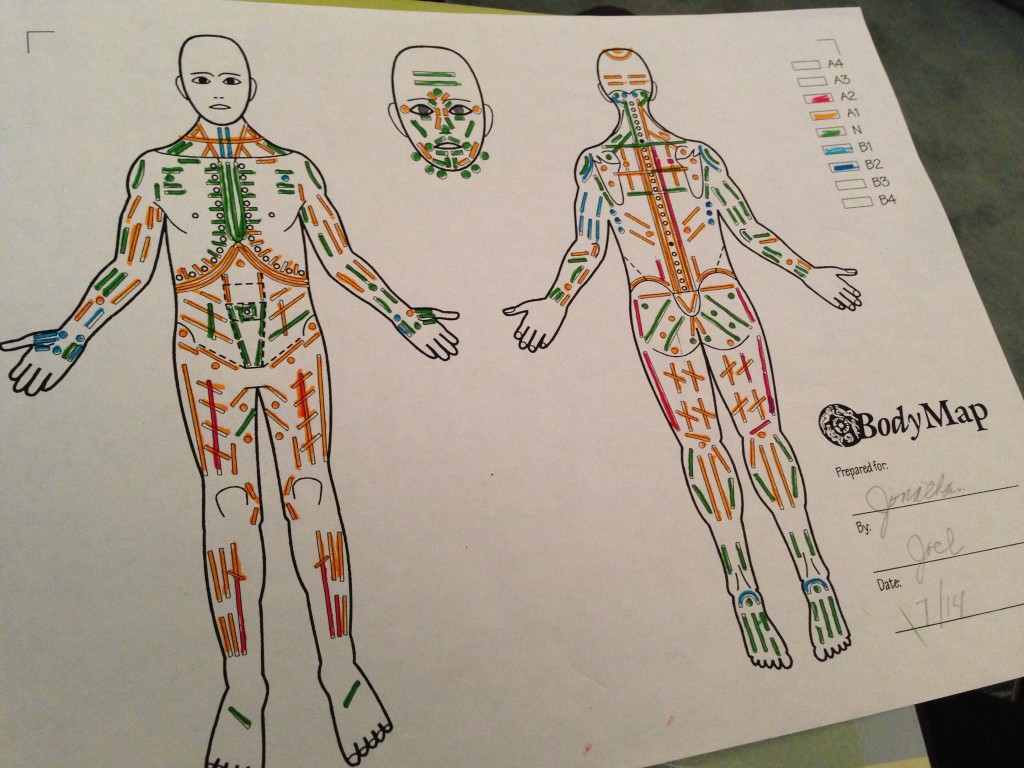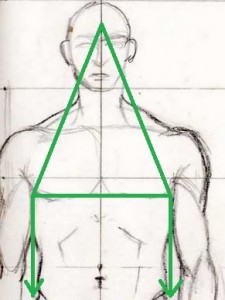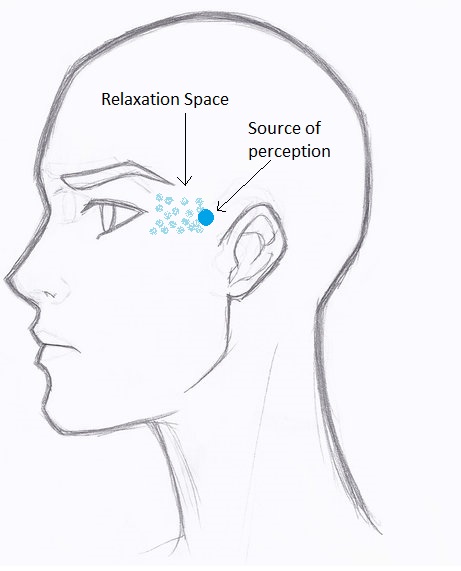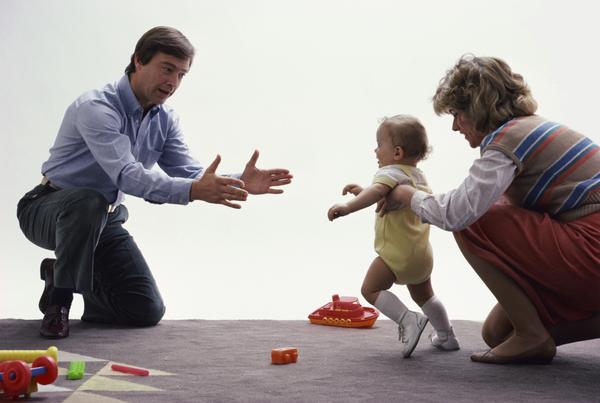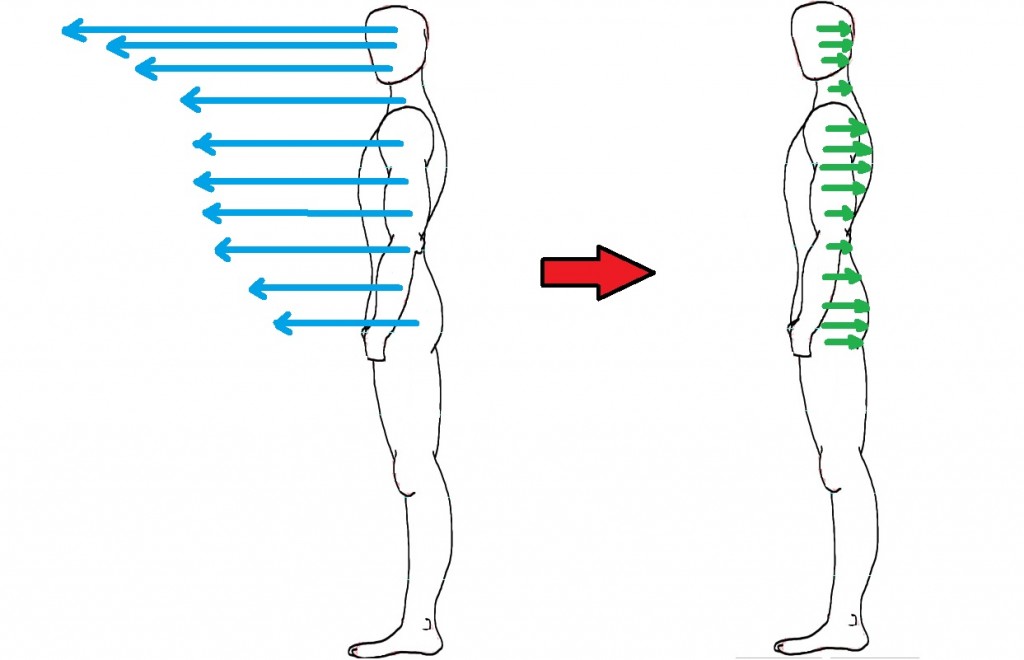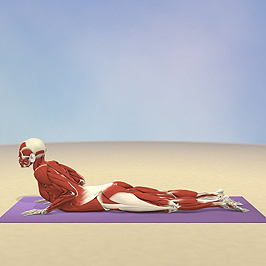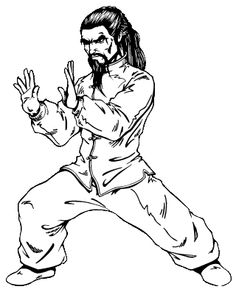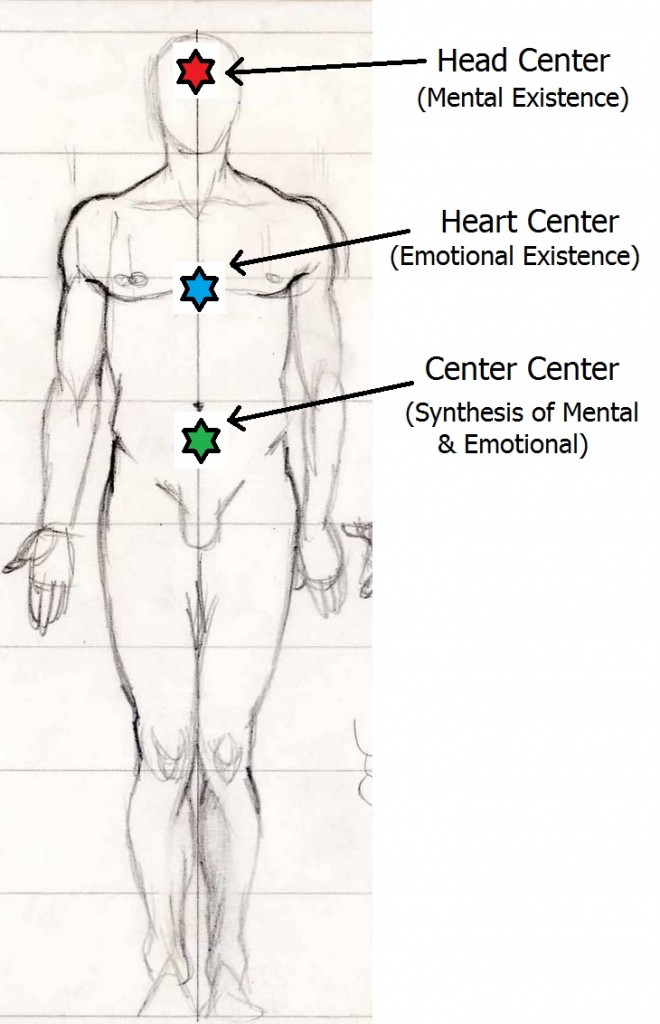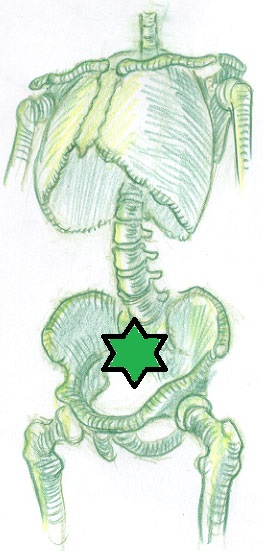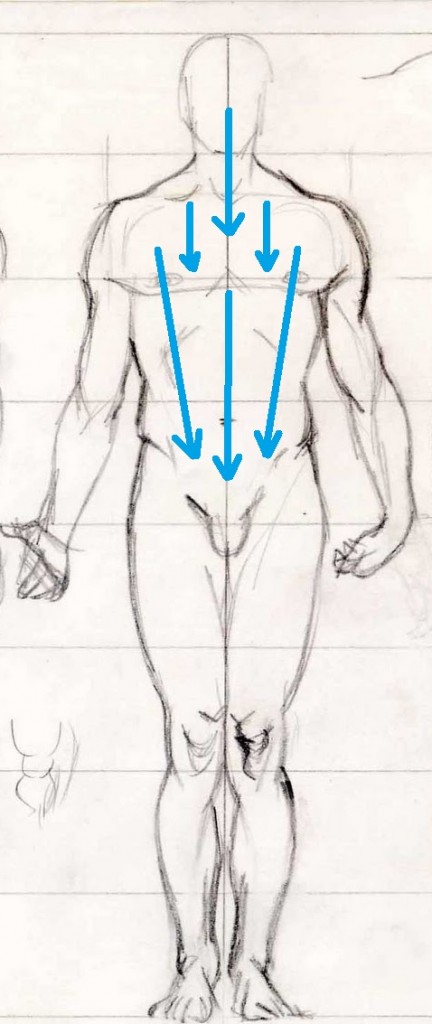My Bodymap Analysis
Recently I had a Bodynamic Bodymap done by Joel Isaacs one of only a few people in North America trained to do them. The process takes about 3 hours as approximately 150 muscles and fascia are tested individually for their elasticity. It is the single most powerful self discovery and development tool ever created. The purpose of the bodymap is to figure out what issues from childhood are holding a person back emotionally and psychologically in terms of their well being.
Muscles that are hypo-responsive are signified by the colour blue and indicate emotional issues that were overwhelming in early childhood leading to a resignation in the muscle and an underdevelopment of the associated emotional psychological function. Muscles that are hyper-responsive are signified by the colour red and indicate emotional armouring in response to stress. The bodymap is an empirical tool to help determine the development and neural patterning of a persons limbic system as manifested anatomically through the body.
It’s important to note that how hypo/hyper-tonic a muscle is has nothing to do with it’s flexibility, physical strength or it’s size. It has more to do with the level of engagement of the muscle and whether it is chronically under-engaged or chronically over-engaged. This is determined mostly by a persons 24/7 subconscious emotional states. Again it is not just muscles that are being tested but also certain fascia tissue.
The following is my personal bodymap completed July 22, 2014.
As a prelude to being able to understand the following analysis I recommend first reading my article: Bodynamic Character Analysis guide
It fully explains the character structures. What it doesn’t explain is “ego functions” which I will write a post about explaining at some later time. Some of these things may not make sense unless you are familiar with the bodynamic system however hopefully you will get the general idea of how this works and what the therapy targets.
The following is an analysis of muscles that are either hypo-tonic (B1 & B2 – blue) or extremely hyper-tonic (A2 – red). Much of the information comes straight out of the Bodynamic Encyclopedia and is copied direct with slight paraphrasing
In Bodynamics muscles that are hypo-tonic are typically worked on first. They represent lessons of appropriate childhood development that are missing. Muscles and their associated psychological/emotional function are considered psychological and emotional “resources” that help people with daily life. Typically armouring is a result of a lack of resources in other areas. The resources are usually built up first before the compensating armour is “melted” away in order to ensure healthy integration and regulation without catharsis.
While the below analysis is fairly scientific, putting it all together in a meaningful manner is more of a subjective art. One that I aim to get better at with time starting with myself.
A few caveats and notes. Although there are fewer muscles/fascia in the early structures each muscle is arguably more important and so a pure muscle number tally is not necessarily accurate. Issues in earlier structures have a far greater impact on a person’s life and affect all the subsequent structures. Also some muscles are engaged across multiple structures and ego functions adding further complexity. Also some muscles/fascia may comparatively have a greater impact than others. Plus this may vary from individual to individual depending on all the other variables.
No two people are exactly alike and every person perceives, interprets and responds to the world in a unique fashion. The bodymap is the most accurate tool at describing those various nuances.
1. Prenatal & Perinatal
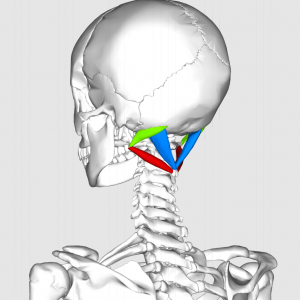 Suboccipitals, medial part #100, pg.289 – hypo-tonic
Suboccipitals, medial part #100, pg.289 – hypo-tonic
- Ego Function: Cognitive Skills (a) orienting
- Psychological Function: sensation of right to have strength/power – instincts
- Development: seeking and sucking reflexes
- Activated by: Rotating head side to side slightly; lifting chin
.
.
 Plantar aponeurosis (fascia) #33, pg.117 – hypo-tonic
Plantar aponeurosis (fascia) #33, pg.117 – hypo-tonic
- Ego Function: Grounding & Reality testing (a) ability to stand one’s ground feel rooted and supported by it; Cognitive Skills (c) understanding; Self-Assertion (c) forward momentum and sense of direction
- Psychological Function: A clear sensation of oneself as a physical person; integration of intuition; forward momentum & sense of direction
- Development: Extension during birth; beginning of walking reflex
- Activated by: lift the heel or toes from the floor
2. Existence
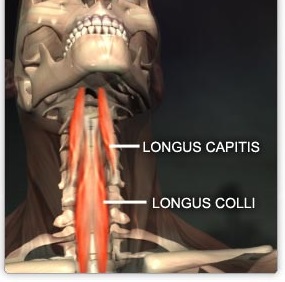 Longus capitis & longus colli #110, pg.315 – hypo-tonic
Longus capitis & longus colli #110, pg.315 – hypo-tonic
- Ego Function: Positioning (a) stance toward life & (e) orienting; Grounding & Reality testing (c) extrasensory perception; Cognitive Skills (a) orienting; Management of energy (b) containment of high level energy
- Psychological Function: Integrating spirituality into physical body; Integrating surroundings kinestheticaly; connect intuition, thoughts & body; accepting energy of instincts
- Development: balancing head on neck; anchoring it to the body
- Activated by: moving nose slightly downward while lengthening back of neck
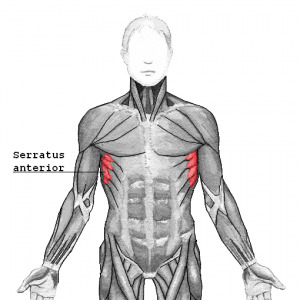 Serratus anterior, superior part #8a, pg. 59 – hypo-tonic
Serratus anterior, superior part #8a, pg. 59 – hypo-tonic
- Ego Function: Connectedness (b) heart contact/opening; Interpersonal Skills (a) reaching out
- Psychological Function: wanted & loved for who you are; reaching out with breath & receiving contact to the heart through eyes & breath
- Development: child is able to influence those he has contact with
- Activated by: Widening back or moving scapulas apart
3. Need
 Serratus anterior, middle part #8b, pg. 59 – hypo-tonic
Serratus anterior, middle part #8b, pg. 59 – hypo-tonic
- Ego Function: Connectedness (b) heart contact/opening; Interpersonal Skills (a) reaching out
- Psychological Function: you are loved no matter what your needs are; contain sensations & emotions while satisfying needs
- Development: child pushes himself up while lying on stomach
- Activated by: Widening back or moving scapulas apart
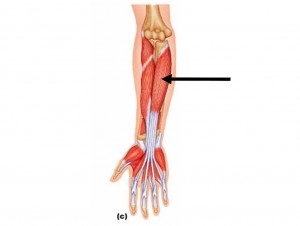 Flexor digitorum profundus #75, pg. 231 – hypo-tonic (left side only)
Flexor digitorum profundus #75, pg. 231 – hypo-tonic (left side only)
- Ego Function: Cognitive Skill (b) cognitive grasp; Interpersonal Skills (b) gripping and holding on
- Psychological Function: grasp/understand words describing the world and emotions; maintain close contact and hold on to what one wants
- Development: child grasps and holds things, takes them to the mouth
- Activated by: flexing joints in the fingers, especially distal ones
Palmar aponeurosis #76, pg.235 – hypo-tonic (one side only)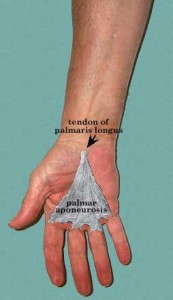
- Ego Function: Cognitive Skills (b) cognitive grasp; Interpersonal Skills (b) gripping and holding on
- Psychological Function: consistency in contact with people and things, sensing and feeling in the world; grasp the world, hold on to it
- Development: child able to grasp things firmly
- Activated by: stretching out the fingers
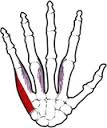 Flexor digiti minimi brevis #82, pg. 251 – hypo-tonic
Flexor digiti minimi brevis #82, pg. 251 – hypo-tonic
- Ego Function: Cognitive Skills (b) cognitive grasp; Self Assertion (a) manifesting ones power; Interpersonal Skills (b) gripping and holding on
- Psychological Function: think in abstract way & form opinion; flexible in discussion; beginning & maintaining dialogue with others
- Development: fine motors skills with hand
- Activated by: Moving little finger and thumb towards each other
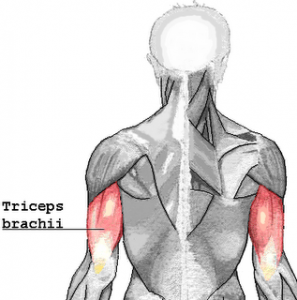 Triceps brachii, long head, prox part #85a, pg. 255 – hypo-tonic (left side only)
Triceps brachii, long head, prox part #85a, pg. 255 – hypo-tonic (left side only)
- Ego Function: Interpersonal skills (e) pushing away and holding at distance
- Psychological Function: pushes away in relation to unwanted things and persons; saying “no” in close relationships
- Development: push oneself away; lift oneself up from lying on stomach
- Activated by: extending elbow and moving arm backward
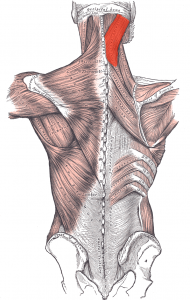 Splenius capitis #99, pg. 285 – hypo-tonic (left side only)
Splenius capitis #99, pg. 285 – hypo-tonic (left side only)
- Ego Function: Posting (e) orienting); Cognitive skills (a) orienting
- Psychological Function: Maintaining connection to self while perceiving surroundings; experiencing the world and obtaining words about it
- Development: When lying on stomach, child lifts head to look around; also turns head away when wanting to break contact
- Activated by: turning head side to side
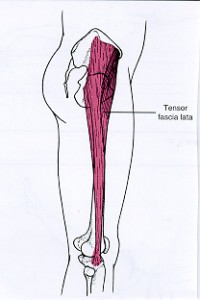 Tensor fascia lata #22, pg.89 – hyper-tonic
Tensor fascia lata #22, pg.89 – hyper-tonic
- Ego Function: Social Balance (b) pulling oneself together/letting go; Energy management (c) self-containment
- Psychological Function: Self-regulating one’s own needs; mastering the building up of needs
- Development: when child begins to roll and creep; also moving into sitting position from lying position
- Activated by: rotating leg medially in the hip joint
4. Autonomy
 Serratus anterior, inferior part #8c, pg. 59 – hypo-tonic
Serratus anterior, inferior part #8c, pg. 59 – hypo-tonic
- Ego Function: Connectedness (b) heart contact/opening; Interpersonal Skills (a) reaching out
- Psychological Function: you are loved for your curiosity & impulses; space to enjoy oneself & freedom to explore world and own one’s emotions without losing contact
- Development: child pushes himself up while lying on stomach
- Activated by: Widening back or moving scapulas apart
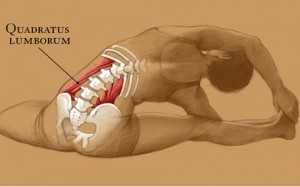 Quadratus lumborum #11, pg.65 – hyper-tonic – (left side only)
Quadratus lumborum #11, pg.65 – hyper-tonic – (left side only)
- Ego Function: Social Balance (a) balancing own needs/feelings/desires against others’ expectations
- Psychological Function: Maintaining awareness of oneself and one’s own impulses while mirroring others
- Development: Creeping & crawling; standing on one leg
- Activated by: While standing pull one hip up towards ribs with a stretched leg
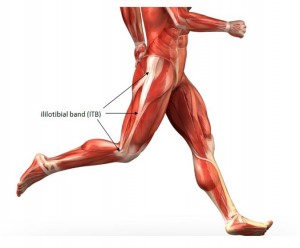 Iliotibital tract #23, pg.91 – hyper-tonic
Iliotibital tract #23, pg.91 – hyper-tonic
*Also applies to: Will, Love/Sexuality, Opinion, Solidarity/performance* +4
- Ego Function: Social Balance (b) pulling oneself together/letting go; Energy management (c) self-containment
- Psychological Function: containment of energy with feelings and aspects of all above listed structures
- Development: movements of the knee
- Activated by: turning leg laterally and backward in hip joint; activate tensor fascia lata or glutes
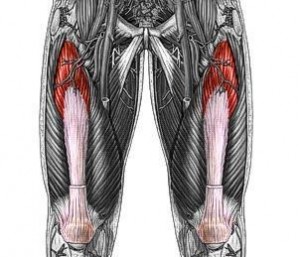 Vastus intermedius, distal part #43c, pg. 145 – hyper-tonic – (left-side only)
Vastus intermedius, distal part #43c, pg. 145 – hyper-tonic – (left-side only)
- Ego Function: Boundaries (c) personal energetic space
- Psychological Function: creating personal space; releasing energy without losing connection
- Development: crawling
- Activated by: hold the kneecap
5. Will
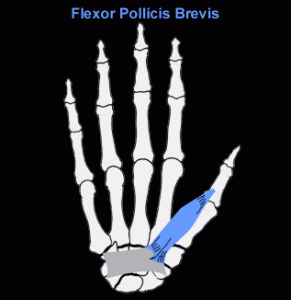 Flexor pollicis brevis #78, pg. 239 – hypo-tonic – (right-side only)
Flexor pollicis brevis #78, pg. 239 – hypo-tonic – (right-side only)
- Ego Function: Cognitive skills (b) cognitive grasp
- Psychological Function: process thinking; operational to abstract
- Development: catching a ball
- Activated by: Flexing thumb toward the palm
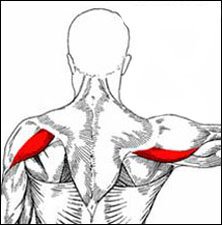 Deltoid, posterior part #84b, pg. 253 – hypo-tonic
Deltoid, posterior part #84b, pg. 253 – hypo-tonic
- Ego Function: Boundaries (e) making space for oneself in social contact; Interpersonal Skills (g) taking on assignments
- Psychological Function: making room for own choices; doing assignments from one’s own desire
- Development: carrying things on the back (backpack); throw a ball with precision
- Activated by: raise arm up and out from side
 Triceps brachii, medial head #85c, pg.255 – hypo-tonic – (left-side only)
Triceps brachii, medial head #85c, pg.255 – hypo-tonic – (left-side only)
- Ego Function: Interpersonal skills (e) pushing away and holding at distance
- Psychological Function: holding on to one’s “no”
- Development: push away and hold at distance; push heavy things
- Activated by: extending elbow and moving arm backward
6. Love/Sexuality
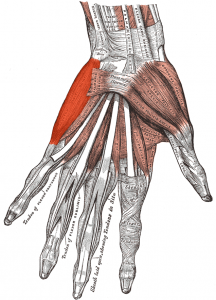 Abductor digiti minimi #81, pg.247 – hypo-tonic
Abductor digiti minimi #81, pg.247 – hypo-tonic
- Ego Function: Cognitive skills (b) cognitive grasp; interpersonal skills (f) releasing, letting go; Gender Skills (e) manifestation of sensuality and sexuality
- Psychological Function: grasping one’s own sensual & sexual appeal/effect; flexibility in alliances; flirting and showing on’es sensuality & sexuality
- Development: had fine motor skills; drinking from a cup
- Activated by: moving the little finger away from the others
 Tricep brachii, lateral head, prox. part #85b, pg.255 – hypo-tonic (left-side only)
Tricep brachii, lateral head, prox. part #85b, pg.255 – hypo-tonic (left-side only)
- Ego Function: Interpersonal skills (e) pushing away and holding at distance
- Psychological Function: saying “no” and pushing away in relation to sensuality and close contact (family & close friends)
- Development: skip rope; ride a bicycle
- Activated by: extending elbow and moving arm backward
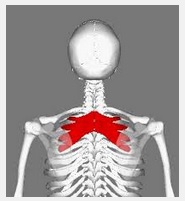 Serratus posterior superior, caudal part #4, pg.51 – hyper-tonic (right side only)
Serratus posterior superior, caudal part #4, pg.51 – hyper-tonic (right side only)
- Ego Function: Connectedness (b) heart contact/opening; gender skills (c) experience of gender role
- Psychological Function: have an open heart to give and receive; you cannot give the heart away, but you can give from the heart and receive with the heart ;; have an open heart in filly yourself out and accept/integrate social gender role
- Development: Child fills lungs fully into upper part of the chest at the back; child copies gender roles
- Activated by: Taking a deep breath into the upper back
7. Opinions
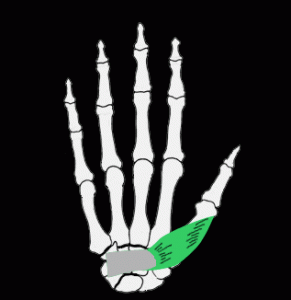 Opponens pollicis #80, pg.243 – hypo-tonic (left-side only)
Opponens pollicis #80, pg.243 – hypo-tonic (left-side only)
- Ego Function: Cognitive Skills (b) cognitive grasp; Self-Assertion (a) manifest one’s power; Interpersonal Skills (b) gripping and holding on
- Psychological Function: forming one’s own opinions; manifest one’s own opinions (oppose); holding on to one’s opinions & being flexible in discussion
- Development: fine motor hand dexterity
- Activated by: Moving the thumb and little finger towards each other
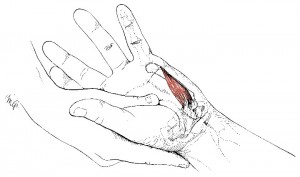 Opponens digiti minimi #83, pg.251 – hypo-tonic
Opponens digiti minimi #83, pg.251 – hypo-tonic
- Ego Function: Cognitive Skills (b) cognitive grasp; Self-Assertion (a) manifest one’s power; Interpersonal Skills (b) gripping and holding on
- Psychological Function: Forming own opinions by comparing to previous known information; flexibility in discussion; maintaining dialogue (cognitive exchange)
- Development: Fine motor hand skills
- Activated by: moving little finger and thumb towards each other
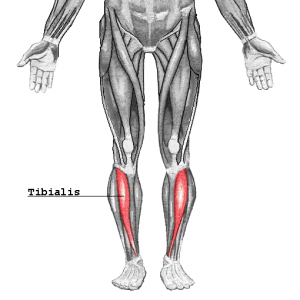 Tibialis anterior, distal part #39, pg.131 – hyper-tonic
Tibialis anterior, distal part #39, pg.131 – hyper-tonic
- Ego Function: Grounding & Reality Testing (b) relationship between reality and fantasy/imagination; Cognitive Skills (d) grasp of reality (ability to apply cognitive understanding to different situations)
- Psychological Function: testing one’s imagining and thoughts; ability to “dance” between the abstract and concrete
- Development: bouncing on feet without leaving the ground
- Activated by: lifting the fore-foot with the heel on the ground
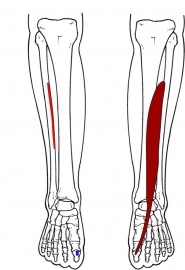 Extensor hallucis longus #41, pg.135 – hyper-tonic (left-side only)
Extensor hallucis longus #41, pg.135 – hyper-tonic (left-side only)
- Ego Function: Grounding & Reality Testing (b) relationship between reality and fantasy/imagination; Cognitive Skills (d) grasp of reality (ability to apply cognitive understanding to different situations)
- Psychological Function: ability to root in one’s values and test them in a group
- Development: Child lift’s big toe; hopping on one foot; triple jump
- Activated by: Lift big toe away from floor
8. Solidarity/Performance
Adductor pollicis brevis #77, pg. 237 – hypo-tonic – (right-sid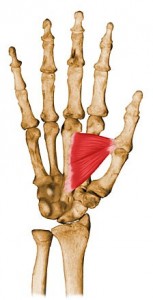 e only)
e only)
- Ego Function: Cognitive skills (b) cognitive grasp
- Psychological Function: Take a survey in group and make room for new points of view
- Development: Child can receive a ball; preparing to catch
- Activated by: spreading the finger; moving the thumb at a right angle away from the other fingers.
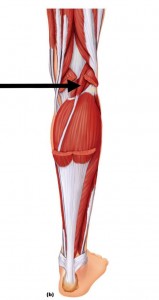 Plantaris #27, pg.101 – hyper-tonic (right-side only)
Plantaris #27, pg.101 – hyper-tonic (right-side only)
- Ego Function: Social balance (e) balance of managing stress and resolving it; Management of energy (b) containment of high-level energy
- Psychological Function: contain stressful situations & believing one will get through; Being flexible in staying or running away from threatening situations
- Development: Running & jumping
- Activated by: Stretching fully in ankle joint as if jumping; resisting a push from the ball of the foot while curling toes
Overall Themes:
Character Structures
The results mostly confirmed what I already knew based on the character structure descriptions about myself.
- Early Existence – Mental …. fairly strong tendency to dissociation here, compounded by hypo-tenacity from Prenatal & Perinatal
- Early Need – Despairing …..the single structure requiring the greatest attention as it has the least resources
- Autonomy – Mostly healthy with a slight deviation to Late
- Will – All early…although personally I feel I am more judgemental than self-sacrificing. This result largely contradicts my personal experience.
- Love/Sexuality – on the side of early love/romantic
- Opinions- results are mixed, although I tend a bit more to late(opinionated) rather than early (sullen)
- Solidarity/Performance – Fairly balanced, the structure with the least issues
Ego Functions Tally
The following is a list of ego functions and the number of times each one came up for me. This gives me a good idea of which ego functions are lacking the most and need to be focused on in terms of my personal development. Listed in order of personal importance:
Cognitive Skills (Total: 17)
- (a) orienting +4
- (b) cognitive grasp +9
- (c) understanding +1
- (d) grasp of reality (ability to apply cognitive understanding to different situations) 1 + 2 = 3
Interpersonal Skills (Total: 16)
- (a) reaching out +4
- (b) gripping and holding on +6
- (e) pushing away and holding at distance +4
- (f) releasing, letting go +1
- (g) taking on assignments +1
Management of energy (Total: 10)
- (b) containment of high level energy 2 + 1 = 3
- (c) self-containment 1 +6 = 7
Social Balance (Total: 9)
- (a) balancing own needs/feelings/desires against others’ expectations +1
- (b) pulling oneself together/letting go 1 + 6 = 7
- (e) balance of managing stress and resolving it +1
Connectedness (Total: 5 )
- (b) heart contact/opening 4 + 1 = 5
Grounding & Reality testing (Total: 5)
- (a) ability to stand one’s ground feel rooted and supported by it +1
- (b) relationship between reality and fantasy/imagination 1 + 2 = 3
- (c) extrasensory perception +1
Self-Assertion (Total: 5)
- (a) manifesting ones power +4
- (c) forward momentum and sense of direction +1
Positioning (Total: 4)
- (a) stance toward life +1
- (e) orienting +3
Boundaries (Total: 2)
- (c) personal energetic space +1
- (e) making space for oneself in social contact +1
Gender Skills (Total: 2)
- (e) manifestation of sensuality and sexuality +1
- (c) experience of gender role +1
Conclusions:
According to the Pareto principle also known as the 80-20 rule, roughly 80% of the effects come from 20% of the causes. This applies very well here. The bodymap allows you to quickly hone in on the major problem areas in a persons life. Working on those will then likely solve many other issues without specifically targeting them. This simplifies things immensely as the above can at first seem quite daunting.
Looking at my bodymap overall, the colours that appear the most are green and orange which are considered relatively healthy. So on the whole I am probably close to 80% healthy and 20% unhealthy. In further breakdown however there is a stronger tendency towards hypo-tonic or resignation especially in earlier structures and a slight tendency towards hyper-tonic in later structures. It is the earlier ones that are of most concern and need the most work.
The two most significant structural issues are
- Early Existence known as mental
- Early Need known as despairing
It’s the combination of these two structures that are the root of the vast majority of my personal problems. Read my guide on structures to learn more what they are about because I won’t repeat it all here.
Now spinning of those two structures are four ego functions of note. In order of importance they are:
- Cognitive Skills
- Interpersonal Skills
- Management of Energy
- Social Balance
Early Existence – Mental:
It may seem paradoxical however being of strong mental existence negatively affects certain cognitive skills especially those dealing with physical reality. Mental existence is described as being disconnected/dissociated from the body and emotions and you can quickly see how that would adversely impact interpersonal skills, energy management and social balance.
Thus the most important thing I need to work on first is connecting with my body and my emotions primarily by raising my awareness of internal somatic sensations. The best way of doing this is by engaging the longus capitis & longus colli muscles in the neck. It’s these muscles that really act as the energetic conduits from my mental head to the rest of my body. In the bodymap they are hypo-tonic and therefore virtually offline which leads to me feeling like my entire self is inside my head. The energy is literally trapped inside my head and there is a disconnect in information/consciousness/energy flow between my head and the rest of my body. I can become quite concious of this disconnect especially when my emotions in my gut and heart are telling me something different than the mental thoughts in my head. This allows me to become aware of my own cognitive dissonance and how various mental biases may conflict with what I am actually feeling.
Activating this neck muscle is what anchors my head to my body and in bodynamics this is known as “orienting” in the sense of orienting to physical reality. This will in turn give me a better “grasp of reality” again in the physical sensational sense. As my sense awareness for my environment improves so does my “cognitive grasp” of it which is the cognitive skill I am lacking the most.
I want to briefly try and describe this one. “Cognitive grasp” to me really is about being able to take the present moment and environment really in…all the way. This is really difficult when you live in the mental land of future and past thoughts, planning, worries, anxiety, abstract ideas and so forth. This explains partially why I often have time anxiety and always feel under pressure (will issue) to be going somewhere and doing something while mentally planning (will issue) the next thing all at once. It’s really a type of running away from the present moment. This because it is difficult for me to fully connect with the present moment and have it be interesting enough (late autonomy issue).
With the longus capitus being offline, the internal mental world becomes as a result more exciting (late autonomy issue) than the external physical world as I am largely disconnected form all the physical sensations and emotions of my body.
I activate and engage the longus capitis, by slightly contracting them by moving my nose slightly downward while lengthening the back of my neck. While doing this I focus on channelling all the consciousness awareness previously “trapped” in my head and flooding the rest of my body with it via the lognus capitis “conduits”. Then I also strongly tune into the local environment and the physical sensations and emotions present in my body.
It has a slight triangle effect where I feel the middle of my forehead connected to two points just below my serratus muscles like so:
So what this does is ground my head to my body and then after I ground the rest of my body to the ground through anchoring my feet into the floor along the lines as indicated by the arrows above.
The effect this has is that it also brings a surge of energy into my serratus msucles and my arms and hands making them feel more alive and powerful. These are the areas of my body that have the greatest degree of hypo-tenacity/resignation.
The serratus muscles after the longs capitis are the next most important area for me to develop and work on. I want to focus in specifically on how it relates to Mental Existence structure. In terms of interpersonal skills the psychological function here is: “reaching out with breath & receiving contact to the heart through eyes & breath”.
To me that statement is very profound and describes an ability of consciousness in terms I have never really read before.
When you breath someone else and the surrounding environmental reality in through the eyes, you are validating and affirming their personal creative existence and the consensus reality you both find yourself in. This makes the present moment very profound, because no other like it has existed before. This is done primarily emotionally as the eyes breath in and take to the heart and the mouth breathes in more to the gut. This also adds to the cognitive grasp the ego has on reality enriching and validating it, plus making the ego feel more safe and secure as well. It really creates a new dimension of security within the self that synthesizes the mental and the emotional as the eyes and mouth both exist in the “mental” head and connect it to emotions felt primarily in the torso (heart & gut) and the lower parts of the body.
Again the longus capitis is the energetic conduit through which this breathing in to the heart and gut takes places and thus it needs to be active and engaged to facilitate the flow of the mental, emotional and physical nourishing inhale and the relaxing exhale.
The ability to receive/perceive reality and fully take it in to heart externally validates/affirms outer reality/experience. It’s a near simultaneous inner motion of inhaling through the eyes and mouth while also exhaling.The emotional tone of the exhale is important. Ideally it emits a relaxation that has a strong relaxing sense of security in existence.
In mental existence the eyes project outwards into the distance, away from physical reality and the present moment. In early need the eyes have a sucking, yearning expression. These two structure combined give a yearning fro the future type look.
A good strategy to counteract and remedy this is to get behind your eyes. In mental existence they mental self is project up and out, and in early need the mental self is seeking to merge with a person outside of the self. Both structures lead to not being inside the self. Getting behind your eyes prevents the mental/need outward projection. It puts you back inside your self.
The next step is to relax the space right behind the eyes. This should relax your brain and your eyes, and tends to work better than trying to relax the eyeballs themselves. Your source of vision should come from behind the space behind your eyes. As if you were looking through the relaxing space. This will also have the effect of relaxing and brining into focus your visual perceived reality. It gives it more solidity.
Being behind your eyes, and really inside yourself facilitates a better connection with others. The more you can be in yourself and comfortable with that, the more others can also feel at ease being inside themselves. Mutual connection can be strengthened in this way, and empathy as well. In early need it’s the opposite of the tendency and desire to merge and give up on the self, in order to gain nourishment form the other. By getting behind both your eyes it breaks the asymmetry of late need where one eye is pulling in, and the other pushing out.
Another strategy I employ is to look downward, almost as if I were looking down into my body. This again activates the requisite neck muscles and I use this to “check in” to my heart feelings and my centre/abdominal feelings.
The early love structure also negatively affects mental existence. Early love again is largely an escape from sensual reality into the world of fantasy. Working on my early love by developing the sensual/sexual aspects also helps bring me more into my body, and out of my head.
Early Need – Despair:
The primary ego function of the serratus muscles is Connectedness through the sub-function of heart contact/opening. The serratus muscles also expand and flare out during breathing and really are muscles that emotionally and psychologically support the heart. The serratus muscles are energetically in line with the heart horizontally and there is an energetic band that wraps around the chest that connects the chest/heart on the front, the serratus muscles on the side and then stretches across the support muscles across the back.
Because the serratus muscles are hypotonic/offline for me it has the emotional effect of not knowing how to reach out from my heart to the world, and for personal contact. Because the energy is trapped in my head I try then to connect with people via my head/mental thoughts almost exclusively as is characteristic of Mental Existence. This could be described as a type of “emotional unavailability” because genuine heart to heart contact doesn’t exist or it’s very difficult.
Now by engaging the longus capitis facilitating flow to the heart from the head and then supporting it’s opening through the serratus muscles I can finally begin to open my heart to people and the world. This connects the mental energy to my emotional energy in my heart. By then drawing it down to my center a synthesis is achieved here where ultimately the contact is NOT exclusively head-to-head or heart-to-heart, but heart-mind-center to heart-mind-center.
People with Emotional Existence as compared to people with mental existence have the opposite problem, where contact is sought nearly exclusively through the heart. This is unbalanced and unhealthy as well.
The primary way for me to resolve Early Need – Despair is by taking in supportive contact through the serratus muscles.
In the above picture the woman is holding and supporting the child by having her hands wrapped right around the serratus muscles. The man is ready to catch and support the child in the same place. This is where emotionally we take in support for Existence/Need and Autonomy. In the bodynamic therapy session the therapist supports me here and I breathe and take in that support at this location. I am at the point now when I feel despair I can actually feel my serratus muscles hurt as they crave human contact.
Despair is a very powerful emotional and feels like you will lose the relationship and there is no hope you will ever get it back.You are all alone, you’re never going to relate, there’s never going to be anybody there, you can continue to live survive, and live without any joy or love.
My whole life I have never fully felt supported and it is because this somatic-emotional resource was never really developed. Many muscles in the arms and hands extending from the serratus muscles tied in with Need Structure are also hypo-tonic and unresourced. Pulling contact in for emotional nourishment, holding hands, the pinkey muscles (flexor digiti minimi) used for pumping breast milk are all in a state of resignation.
Here cupping and making contact with another person using the palm of hand helps in establishing and taking in contact. The arms and hands in very primitive ways are crucially important here. For example when hugging someone noticing the emotional sensation in the arms as they pull in the other person for heart contact.
Socially this has negatively affect my ego function of Interpersonal Skills which is the second ego function I am lacking in the most.. So things such as reaching out, gripping and holding on, pushing away and holding at distance, releasing, letting go and taking on assignments are areas that are affected.
In order to resolve this I have the therapist, support me under my arms from behind, also holding the therapist hand, as well as pulling the therapist hand inward towards my heart/chest. These psycho-somatic exercises all help establish psychological resource in those muscles.
In greater terms the antidote to despair is self-satisfaction related to emotional and physical nourishment. For most of my life I have just ate food to survive, and never really appreciated it or focused on the satisfactory sense of taste. Slowing my eating down, and then feeling satisfaction in my centre is one strategy I have used. The most important though is when people do support me, and make contact and help me that I begin to feel satisfaction in my serratus muscles. This allows my shoulders to relax and my heart to open up as the foundational muscles below my arms begin to engage and support the upper most part of my my torso.
Early Need has a energetic sucking/yearning type energy flow. Their energy is directed strongly out of their body at other people seeking to merge and fulfil the other persons needs. They are highly “empathetic” in those terms. The following diagram on the left depicts the overall energy flow.
To resolve this it is important to sense into the direction of your overall emotional energetic flow. The antidote to despair is self-satisfaction. Satisfaction in terms of relaxation is felt most strongly in the back of the body. And special notice needs to be taken here to redirect the energy into the back and really feel all the back muscles relax. The feeling is one of having your desires fulfilled with sheer abundance. This will also automatically relax the eyes.
Early need has this aspect to it where the feeling is one of wanting to actively suck someone in and fully merge with them energetically. In the healthy position the energy is more passive, and there is a conjoining that lacks the desperation and void that is at the core of early need desire. The goal is to feel self-fulfilment rather than other-fulfilment.
Having early need in my case has some unsavoury qualities. Early need is strong in mirroring and combined with opinion structure or late will can be caustic. I will quickly tune in to other peoples insecurities due to the survival imperative and then mirror the “worst” aspects of other people back to them. At other times I can shape-shift my persona. Early need is in a way stuck at a very early stage in development where the child does not differentiate from the mother.
While early need mirroring can confer some benefits in terms of empathy as well as exploring other modes of conciousness perception/expression, the downside is that it comes at the cost of your own soul so to speak. Centering covered in the next section is the primary antidote to the early need mirroring issue. The mirroring issue occurs subconsciously therefore it’s important to become concious of the impulse to mirror, so that it can instead be done consciously by choice as desired while maintaining ones center. This is the primary way to maintain one’s own dignity. Moulding yourself to fit another persons needs is a creative survival strategy, however it is inherently undignified because it comes at a loss of maintaining one’s own dignified individuality.
This structure is also important in that the feeling of being wanted and loved for who you are is important. This is often an emotional resource missing in this structure. For me I have difficulty believing people actually would want me, or want to be with me. My heart is closed off to affection from others. Despair then becomes a self fulfilling prophecy. The important thing to change here is to feel what it would be like if someone actually wanted you, to be with you and loved you for who you are. This involves opening up the heart and taking in, and building up the resource of feeling wanted.
To demonstrate this Joel had me do an arm movement where I held my arms outward from my chest to take in love/abundance form the universe. All I felt was fear, by tuning into my emotions when doing this movement. Despair is a fear that no one will love you, or connect with you, and thus the tremendous fear around the heart chakra. People with early need can love others, but can’t take love in themselves. It is something they never learned how.
So believing/assuming/expecting that someone wants to love you, and then to take that in at the heart level is what creates the feeling of satisfaction that is the antidote to despair. The satisfaction that comes from being loved and wanted is what needs to be built up into a new psychological/emotional resource. The heart needs to fill up like a cup, so it doesn’t feel like permanent black hole.
The overarching antidote to need issues both early & late is an embodied feeling of satisfaction.
In following therapy sessions I worked with the insight gained from my personal experiences. My therapist had me lie down on the floor stomach down, and then slowly use my hands and arms and spinal erectors to push just the front part of my body up and take notice of how my visual perspective changed. Exactly like the cobra posture in yoga.
The whole world of form opens up and as your eyes take in the world (where as before I had been staring at the floor) I also had this strong sensation of my body separating from the floor where as before it had been merged with it. This is a childhood developmental stage I had been stuck in, not fully having separated from my environment.
My therapist had me do another movement using my hands and feet and pushing the world of form outward from my body, as in a tai chi like move.
It’s amazing how good that felt doing those moves, really focusing on how I could use my body to psycho-emotionally separate myself from my environment. The important part for me is that as I am pushing the world away from myself to reinforce my own sense of individuality I am simultaneously pushing myself back into myself and that is the part that feels the best. It’s an almost paradoxical manoeuvre/sensation. It also works to separate from people, and combined with the shoulder shrug manoeuvre from will structure it helps unburden the merging I had done with other people in self-sacrificing like ways.
Centering (ego-function):
One of the most important ego functions is known as Centering. This ability is known in many martial arts systems and is focused around the anatomical center of the body called the Dantian. It is known as the energy center of the body and in Nei Kung is the point at which yin and yang energies merge. In the Bodynamic system it acts as the integration point between the mental (yang) and heart (yin) and the goal is to literally center ones being here. You want to move, act, connect and make decisions from this point in the body.
Centering in the “center center” anchors your thoughts and emotions so that you become a more embodied being. Very few people operate their life from this point and are either lost in the head or the heart. Being either heart or head centered is not ideal, and really you wan to merge the two lower in your body where the actual center for your body resides. You ideally want to live your life from this focal point and consistently be aware of it. This is the entry point to your inner (or higher) self; the integration of mind, body and spirit, and also the source of your intuition and creativity.
The pelvis really acts as the floor or foundation of your torso. It’s shaped like a container and really structurally contains the energy of the body and the space right in the middle is the location of your center.
In a centering exercise you practice engaging and feeling all the muscles that surround this space in order to bring you awareness to the location in the middle. Because your center is inside your body it doesn’t really have touch sensation. We can sort of sense our thoughts in our head/brain and we can feel our emotions in our gut or heart. The goal here is to feel our center in a similar way. In SCT it’s called the place where there are no words and what you sense there really is not thought or feeling, but rather an abstract energetic synthesis of the two that can’t really be described using language. In Chinese medicine it is known as the “elixir field” or “sea of qi” which is perhaps the best linguistic description we can give it. Again you really want to anchor and source your emotions thoughts and being from this point. Your authentic self really arises and grows outward from here.
Centering is also the best way to resolve my 3rd most pressing ego function issue; Management of Energy. Centering helps pull-down all that mental excitement energy I feel and experience that is a defense mechanism against despair. This reigns that energy in so it doesn’t overwhelm my brain. It also helps me gain control and anchor anxious emotions.
Children with healthy existence structure if you ask them to locate their inner essence will typically point to this place, where as if you ask the same question of adults they will typically point to their head or heart. Many of us thus have lost our center, our connection with our source self.
Late Autonomy:
My autonomy is mostly healthy. I don’t have the verbal activity changing aspect of most people with late autonomy. I can focus and go deep on anything to a very high degree, much more than most people in general. This post and my website are proof of that.
I do however struggle with feelings of being supported in my autonomy. I often feel like I have to figure out everything on my own and do everything on my own. In general asking for help is something I don’t tend to gravitate towards quickly.
Late Autonomy in the case has a stressful anxious like quality to it and a cortisol inducing like anxiety about it. One strategy I have found particularly useful is to feel support in the lower back. The support muscles for autonomy are the Quadratus lumborum. I have noticed that when I get “stressed” or feel unsupported by others this part of the body tenses up.

It is the area that supports and is below the adrenal glands. Tuning in to this part of the body and feeling support-satisfaction and relaxation here I find particularly effective. Feeling relaxation here encourages the shoulder blades to come down and relax as well as the rest of the back muscles as that part of your body really supports and holds up the bulk of the torso.
I know I am not feeling supported in my autonomy when I begin having anxious dreams that I am having car issues or can’t find my car, or my car is broken or something of that nature.
Dreams can give you a lot of information if you can decipher the developmental theme that is at play and then work with those emotional aspects that need support during the day.
Late Will – Judgemental:
Although the few extreme muscles in this structure show up as early I consider myself to be more late will even though I likely have elements of both early and late. As long as I can nearly remember I have had this background underlying feeling that I am barley aware of because of it’s ubiquitous persistence of feeling like I have to put forth tremendous effort to go anywhere or do anything. This applies to things I do and don’t want to do which is an important realization. There is this subtle feeling of having to “push through” head first so to speak.
The two most prominent things I seem to be pushing through is other people (sullen/late will/distrust/emotions) or my own fatigue. Slow car drivers on the road in front of me really bring out this feeling in me. I expect resistance in nearly everything I do including getting out of bed in the morning. I expect it in all my relationships, and that I need to push through to validate/prove myself.
I feel like I am working tremendously hard when I am not working at all and just sitting around. Just being alive seems to be a task of great effort. It is like having an invisible yoke across my shoulders where I have a consistent workload that needs to be pushed even when I am supposed to be at rest sleeping. The pushing through feels dreadful and that dread is an emotion I have quickly repressed.The dread feels like a grey vortex of despair in my solar plexus chakra area which happens to be the “will” chakra.
Another thing I struggle with is in terms of how judgemental I can be of others, especially their insecurities. At times I struggle to have compassion for others and it feels like my heart has steel plate armor around it. In fact I am subconsciously judging nearly everyone, including myself causing excess negativity to mostly myself. People “weaknesses” feel like a constant threat to my survival and trigger me hard in this structure.
Even attempting to feel compassion at times makes my heart feel incredibly vulnerable and it almost has a wounded like sensation. Letting go of judgements can feel a little bit like a spear being driven through my heart very slowly.
Working with opening my heart and learning to soften the tension I feel towards others is critically important. Finding strength in vulnerability and compassion rather than seeing it as weakness is also important.
I also engage in bruxism which is a late will tactic of holding back emotion as well as clenching of the teeth is used as “efforting” or pushing through against resistance. The muscle here is the Masseter and it’s ego function is management of energy.
In advanced bodynamic trainings one muscle that came up for me specifically in this structure is the pectoralis major – abdominal part. There was tremendous anxiety that would come up when slightly activating this muscle for myself. The two ego functions of this muscle are self-esteem and self-assertion especially also in regards to asserting gender and sensuality/sexuality. When I felt anxiety in these muscles I couldn’t connect it to any specific traumatic events at all. The muscles were definitely hypo as I could feel a quivering of fear in them when they were challenged through subtle activation.
In the weeks following this discovery I spent a lot of time becoming any time I felt anxiety and much to my surprise I could locate most of it in these muscles. A lot of times I could feel my self-esteem being challenged in relation to being able to assert my own needs. Moving through the anxiety and working at building a sense of self worth and building that as a resource here has been tremendously helpful. Also activating it when sexually aroused also gives a fuller feeling of embodying my masculine sexuality and steeping into my own power.
As an antidote to late will I have found that bringing up the feeling and sensations of effortlessness in my body to be supremely helpful. I can feel it spreading across my chest like a warm, smooth energizing silver liquid. It almost feels like things could just happen with no effort. There is this incredible ease with this feeling and sensation. The goal for me here is to have this as my baseline state instead of the pushing through/dread feeling. Sometimes pushing through is necessary especially when there is something that I need to do that I may not necessarily like. However, if that feeling persists and even applies to doing things I enjoy doing even if they are challenging, then something is wrong.
Learning can occur effortlessly. Something that requires tremendous physical effort can be done with mental effortlessness. It’s like a master martial artist, they have tremendous power and speed with an almost zen state of mind. This is what my goal is, this really is what mastery looks like. It’s more a mental/emotional attitude.
Learning how to solve a difficult math problem can feel like it requires an exhausting effort, or it can feel light hearted realizing that it just takes a bit of time and being ok with that.
My will issue comes up a lot with anxiety I have around time. Again with the slow drivers in front of me irritating me even if I have lots of time to get somewhere. Will structure has much to do with planning, and planning requires having a good grasp of time. I am very good with planning which also has to to with the ego function of grounding which I am healthy in.
However I can get too much into a planning mode, where my mind lives in the future too much endlessly planning nearly everything. This takes me out of the present moment. The truth is this is an escape from how I feel in my body and emotions in the present moment, a coping mechanism. Instead of using my autonomy to get away from uncomfortable feelings I appear to use my will.
The feeling of effortlessness is a somatic sensation that can only occur in the present.
Early Love/Sexuality – Romantic:
Working with love/sexuality is important for me to compensate for the early need mother/feminine mirroring issues I have struggled with. Also it helps get me out of my mental and fantasy head.
In this case I am early love which is characterized by a certain kind of rigidity in the back of the body. This gives a stickup the ass kind of look. The rigid structure is shaped by a fear of surrender especially in regards to sensuality and sexuality.
To break the rigidity of the back of the body I find that by focusing on the flow of sensual energy down the front of the body into the hips and groin to be a way to counterbalance “love” with sensuality. Instead of the endless longing for heart contact, you counter balance this with a flow through the centrer into the sacral chakra. This creates more of an energetic balance between feelings of love and feelings of sensuality by connecting the two areas.
In early love, people feel sexual desire at the heart rather than their sacral chakra/groin hips area. Sexual energy then is trapped at the heart and the heart is not equipped to handle this kind of energy nor is it it’s purpose. It becomes then difficult to distinguish between romantic and sexual feelings because they are energetically located within each other leading to a certain level of confusion.
Early love creates a certain kind of detachment from physicality and sensuality/sexuality and often romantic feelings of the heart are idealized and seen as superior to feelings of sensuality. Early love lives in the world of fantasy.
Sensuality is something while it is cantered in the sacral chakra does not exist exclusively there, but also permeates the whole body.
The energetic action and flow starts at the eyes and the mouth and moves down the front part of the chest through the heart chakra down through the centre and energizes the root chakra. Late love/sexuality really has a pulling in and down type of quality about it.
In our earlier years as children desire and need are the same thing. As adults it is important to decouple these so the feelings of both can be distinguished. Often romantic or sexual desire can feel like a survival need if this doesn’t happen.
In my case this I have early need coupled with early love.
Here again activating the pectoralis major – abdominal part brining the chest forwards brings me into the power of my masculinity. Bringing the pelvis forward slightly matching the lead with my groin to that of my chest for balance, and also grounding my sexuality using the four small toes (flexor digitorum longus). Engaging both SCMs and lowering my chin a bit as well as my gaze. In a bodynamic session I also had a therapist put a hand for sensuality support on the trapezious inferior.
Late Opinion – Opinionated:
I have had late opinion, and occasionally when I am annoyed with people I will go into early opinion.
I have done tremendous work in this structure mostly by tuning into and noticing that the compulsion to argue while it may feel exciting, does not actually feel good and peaceful on the other hand. There is an anxiety about being right and trying to prove oneself worth through knowledge (mental existence) and opinions.
Performance/Solidarity:
While I am mostly healthy in this structure, Anne did notice that when I walk a don’t push off the ground using the full range of my toes. Doing this gives a more sense of mastery when walking as opposed to semi-dragging my feet.

